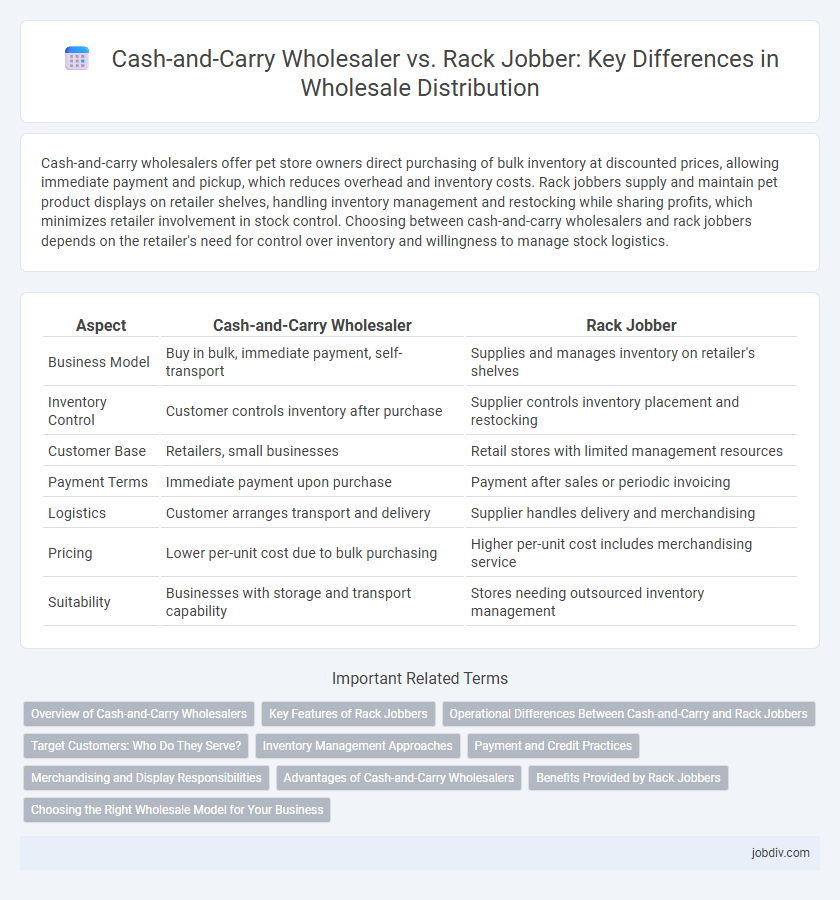Cash-and-carry wholesalers offer pet store owners direct purchasing of bulk inventory at discounted prices, allowing immediate payment and pickup, which reduces overhead and inventory costs. Rack jobbers supply and maintain pet product displays on retailer shelves, handling inventory management and restocking while sharing profits, which minimizes retailer involvement in stock control. Choosing between cash-and-carry wholesalers and rack jobbers depends on the retailer's need for control over inventory and willingness to manage stock logistics.
Table of Comparison
| Aspect | Cash-and-Carry Wholesaler | Rack Jobber |
|---|---|---|
| Business Model | Buy in bulk, immediate payment, self-transport | Supplies and manages inventory on retailer's shelves |
| Inventory Control | Customer controls inventory after purchase | Supplier controls inventory placement and restocking |
| Customer Base | Retailers, small businesses | Retail stores with limited management resources |
| Payment Terms | Immediate payment upon purchase | Payment after sales or periodic invoicing |
| Logistics | Customer arranges transport and delivery | Supplier handles delivery and merchandising |
| Pricing | Lower per-unit cost due to bulk purchasing | Higher per-unit cost includes merchandising service |
| Suitability | Businesses with storage and transport capability | Stores needing outsourced inventory management |
Overview of Cash-and-Carry Wholesalers
Cash-and-carry wholesalers operate as self-service warehouses where businesses purchase goods in bulk at lower prices, enabling efficient inventory management and cost savings. These wholesalers typically require customers to handle their own transportation and payment at the point of sale, streamlining the buying process without delivery services. Focused on supplying retailers, small businesses, and institutional buyers, cash-and-carry wholesalers offer a wide range of products with immediate availability and reduced lead times.
Key Features of Rack Jobbers
Rack jobbers manage inventory and merchandising within retail stores, supplying products directly to store shelves and maintaining stock levels to maximize sales. They retain ownership of the products until sold, reducing retailers' inventory risk and providing specialized product knowledge. This model streamlines supply chain processes, improves shelf space utilization, and enhances product visibility in stores.
Operational Differences Between Cash-and-Carry and Rack Jobbers
Cash-and-carry wholesalers operate through physical warehouses where retailers purchase goods in bulk for immediate payment and transportation, emphasizing self-service and inventory control. Rack jobbers manage and stock products directly on retailers' shelves, maintaining inventory and merchandising while billing retailers only after sales occur. The operational model of cash-and-carry focuses on rapid turnover and wholesale pricing efficiency, whereas rack jobbers specialize in category management and retail shelf optimization.
Target Customers: Who Do They Serve?
Cash-and-carry wholesalers primarily serve small retailers, independent grocers, and businesses that prefer to buy products in bulk and transport them directly from the warehouse, offering lower prices by eliminating delivery costs. Rack jobbers target large retail chains and supermarkets by managing specific product categories within store shelves, ensuring consistent inventory and merchandising without direct purchase by the retailer. Their service models focus on convenience and inventory control for distinct customer segments within the wholesale distribution network.
Inventory Management Approaches
Cash-and-carry wholesalers manage inventory by stocking large quantities of goods in centralized warehouses, allowing retailers to purchase products in bulk with immediate payment and pickup, optimizing turnover rates and reducing carrying costs. Rack jobbers maintain inventory through consignment models where they supply and replenish products directly on retailer shelves, ensuring continuous stock availability without transferring ownership until sale, which minimizes retailer inventory risk and improves shelf management. These contrasting inventory management approaches reflect the wholesale sector's adaptation to diverse retail needs, balancing bulk procurement efficiency against localized, just-in-time product availability.
Payment and Credit Practices
Cash-and-carry wholesalers require immediate payment typically in cash or electronic transfer, minimizing credit risk and facilitating quick inventory turnover. Rack jobbers often extend credit terms to retailers, allowing deferred payment based on agreed billing cycles, which can enhance sales but increase financial exposure. Understanding these payment and credit practices helps businesses optimize cash flow and manage supplier relationships effectively in wholesale operations.
Merchandising and Display Responsibilities
Cash-and-carry wholesalers manage inventory by allowing retailers to purchase goods directly from warehouse locations, emphasizing bulk sales and simplified logistics. Rack jobbers specialize in merchandising by delivering products to retail stores, setting up, stocking, and maintaining dedicated product displays to maximize shelf visibility and sales. Their focus on in-store display and category management contrasts with the cash-and-carry model, which prioritizes quick, large-quantity transactions without ongoing merchandising involvement.
Advantages of Cash-and-Carry Wholesalers
Cash-and-carry wholesalers offer advantages such as immediate product availability and lower procurement costs due to their bulk purchasing model, enabling retailers to reduce inventory holding expenses. Their self-service approach minimizes overhead costs and enhances flexibility in order quantities, supporting efficient stock management for small to medium-sized businesses. Direct access to a wide product range without credit risk streamlines transactions, making cash-and-carry wholesalers a cost-effective and convenient supply chain option.
Benefits Provided by Rack Jobbers
Rack jobbers offer significant benefits by managing inventory directly on retailer shelves, ensuring consistent product availability and reducing out-of-stock occurrences. They enable retailers to minimize inventory investment and operational overhead by handling product placement, merchandising, and replenishment. This hands-off approach allows retailers to focus on core business activities while benefiting from improved shelf organization and faster turnover rates.
Choosing the Right Wholesale Model for Your Business
Choosing the right wholesale model depends on your business structure and inventory control preferences. Cash-and-carry wholesalers require buyers to purchase and transport goods directly, offering lower prices but demanding more upfront investment in stock management. Rack jobbers supply products directly to retailers and handle stocking and merchandising, ideal for businesses seeking minimal inventory risk and enhanced shelf presentation.
Cash-and-Carry Wholesaler vs Rack Jobber Infographic

 jobdiv.com
jobdiv.com